Abstract
In order to test the hypothesis that treatment with glucocorticoids causes pancreatitis in dogs, 18 mongrel dogs were divided into three groups of six individuals, each group receiving prednisone at different doses orally or intramuscularly for two weeks. Two groups consisting of six dogs each served as controls. Treatment for two weeks with oral prednisone at 1.2 mg/kg body weight or at 4 mg/kg body weight daily decreased the serum amylase activities, but increased the serum lipase activities. Postmortem examinations revealed microscopic evidence of mild pancreatitis in only one dog given prednisone, that clinically appeared normal. It was concluded that daily doses of 4 mg prednisone/kg body weight or less given orally or intramuscularly for two weeks do not cause pancreatitis in dogs.
Full text
PDF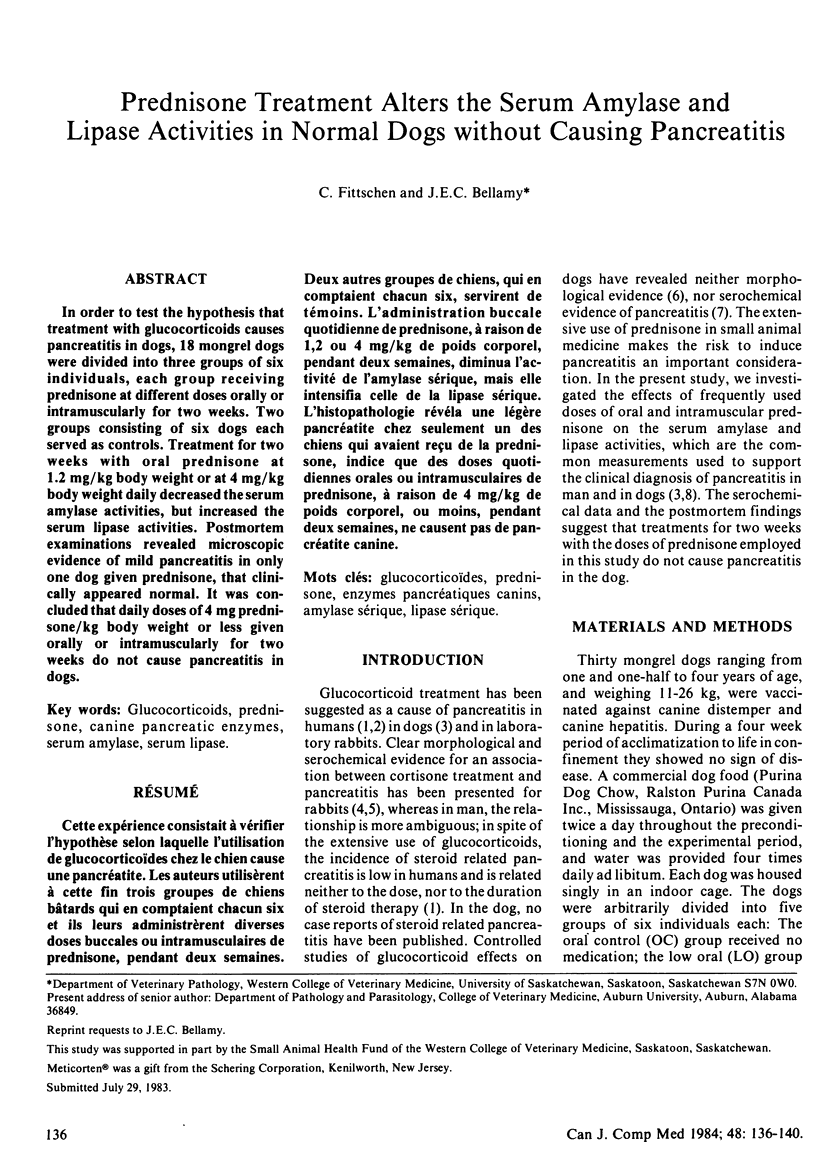
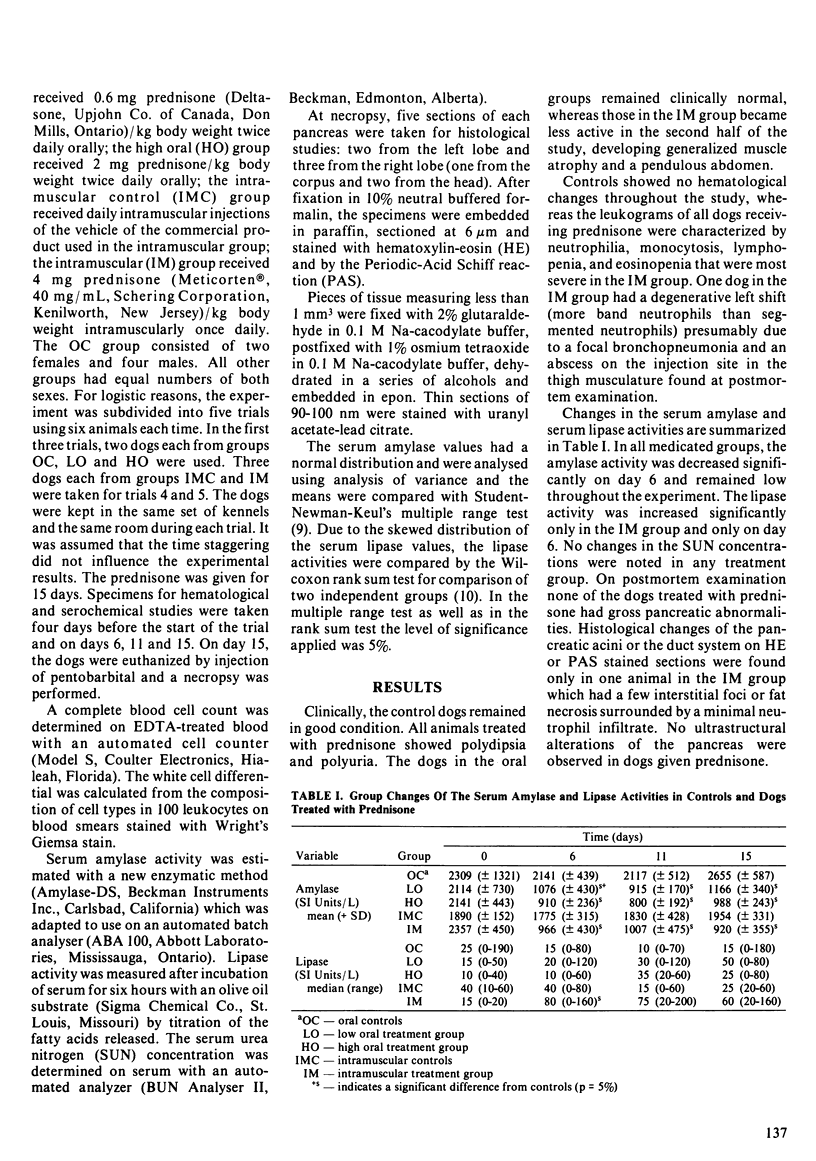
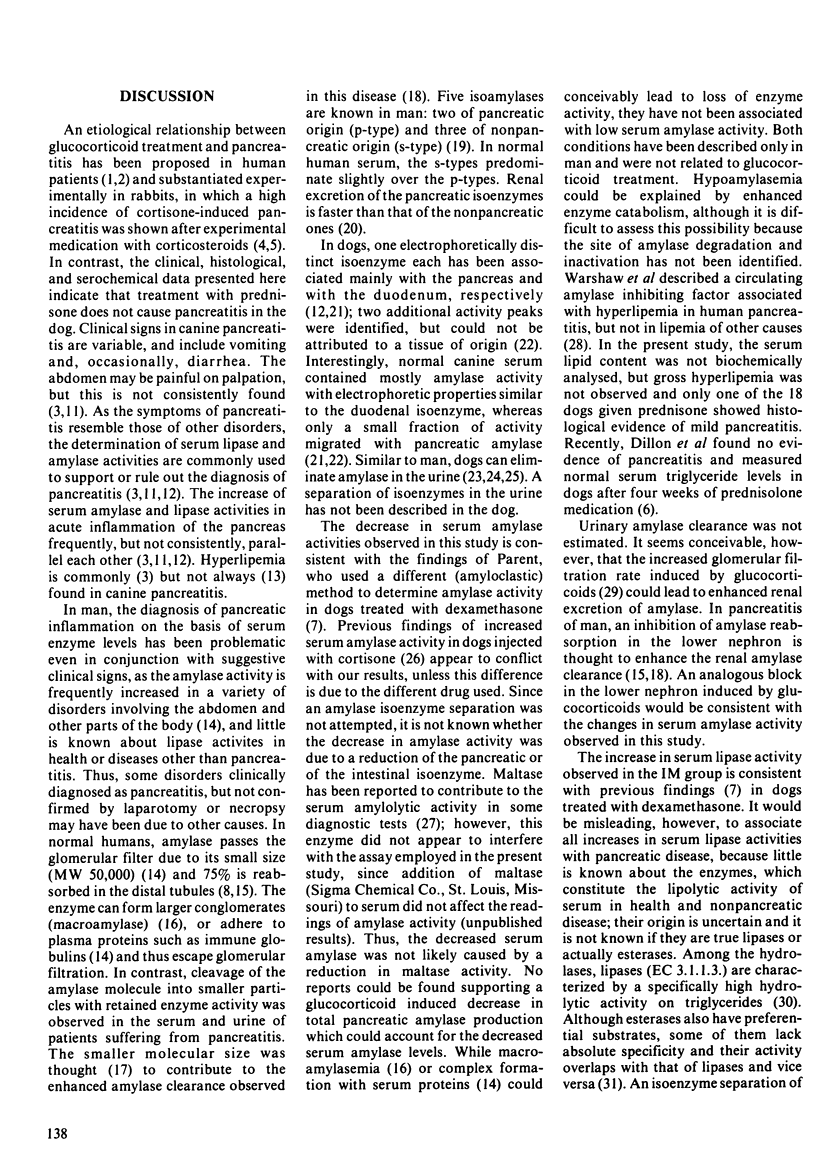
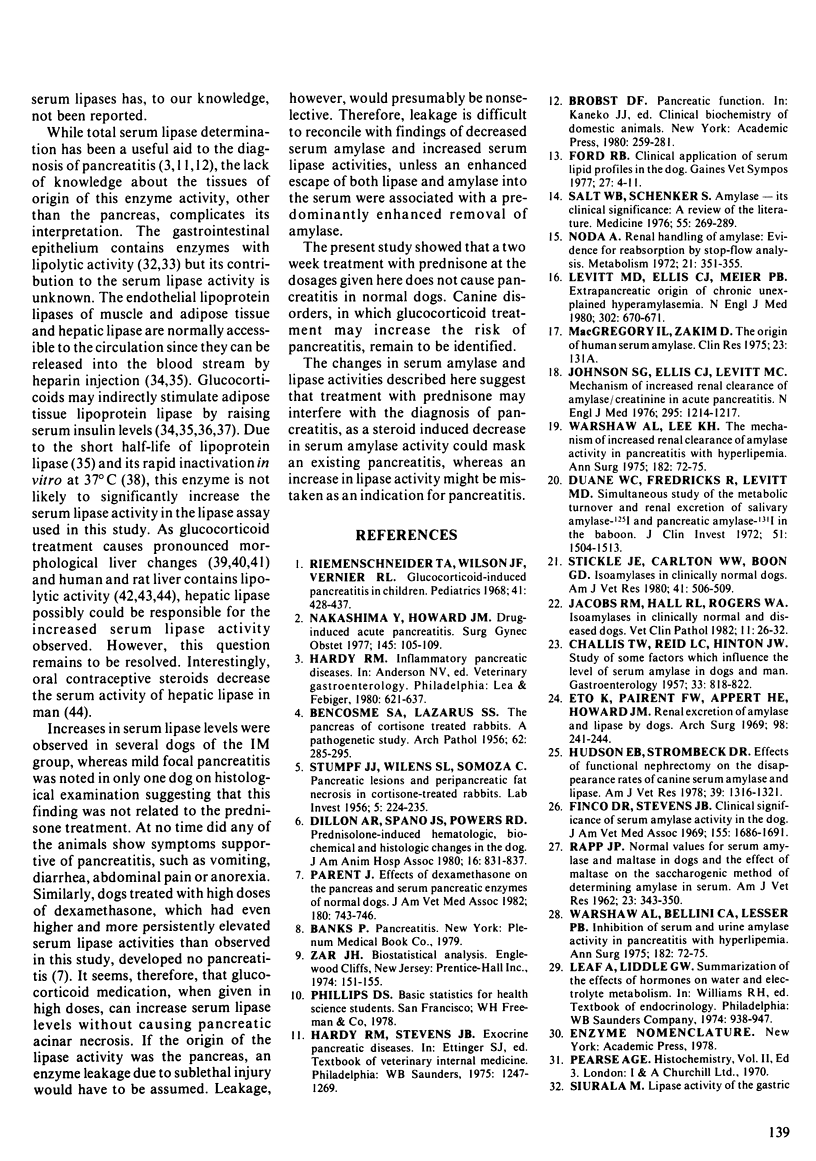
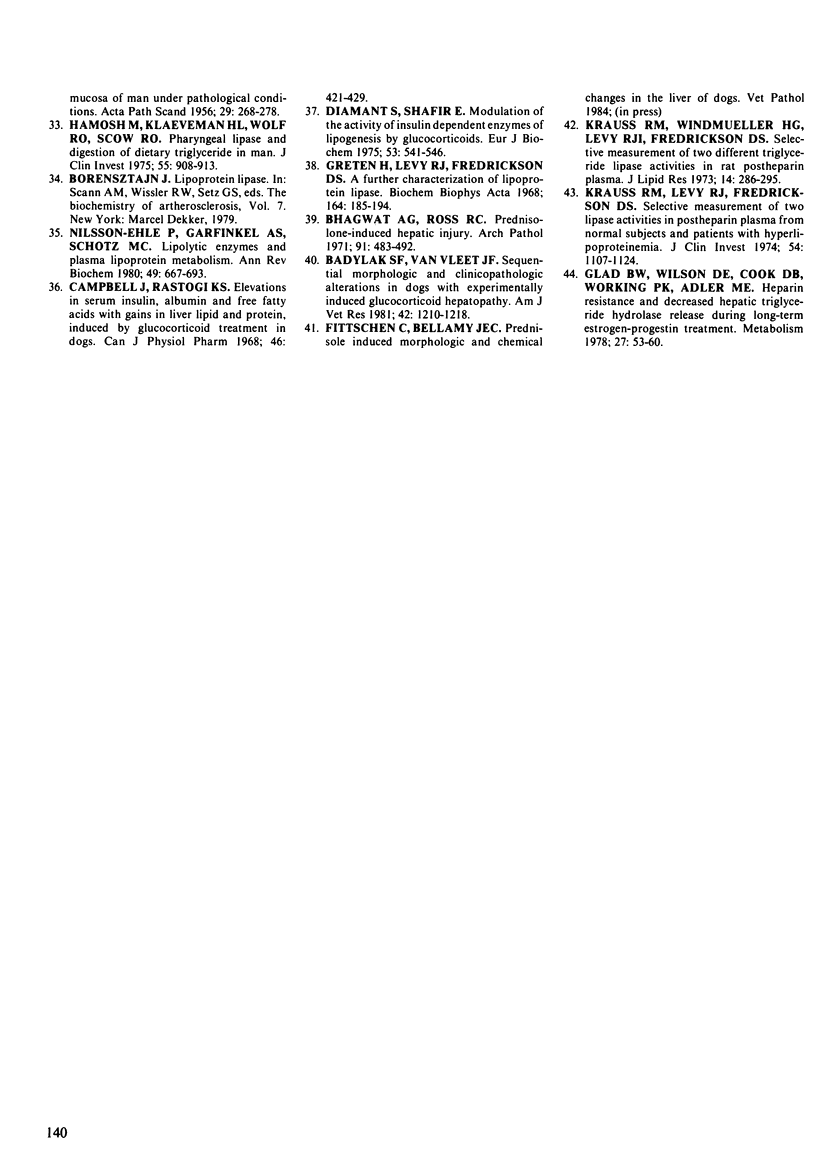
Selected References
These references are in PubMed. This may not be the complete list of references from this article.
- BENCOSME S. A., LAZARUS S. S. The pancreas of cortisone-treated rabbits; pathogenic study. AMA Arch Pathol. 1956 Oct;62(4):285–295. [PubMed] [Google Scholar]
- Bhagwat A. G., Ross R. C. Prednisolone-induced hepatic injury. Ultrastructural and biochemical changes in rabbits. Arch Pathol. 1971 Jun;91(6):483–492. [PubMed] [Google Scholar]
- CHALLIS T. W., REID L. C., HINTON J. W. Study of some factors which influence the level of serum amylase in dogs and humans. Gastroenterology. 1957 Nov;33(5):818–822. [PubMed] [Google Scholar]
- Campbell J., Rastogi K. S. Elevation in serum insulin, albumin, and FFA, with gains in liver lipid and protein, induced by glucocorticoid treatment in dogs. Can J Physiol Pharmacol. 1968 May;46(3):421–429. doi: 10.1139/y68-064. [DOI] [PubMed] [Google Scholar]
- Diamant S., Shafrir E. Modulation of the activity of insulin-dependent enzymes of lipogenesis by glucocorticoids. Eur J Biochem. 1975 May 6;53(2):541–546. doi: 10.1111/j.1432-1033.1975.tb04097.x. [DOI] [PubMed] [Google Scholar]
- Duane W. C., Frerichs R., Levitt M. D. Simultaneous study of the metabolic turnover and renal excretion of salivary amylase- 125 I and pancreatic amylase- 131 I in the baboon. J Clin Invest. 1972 Jun;51(6):1504–1513. doi: 10.1172/JCI106947. [DOI] [PMC free article] [PubMed] [Google Scholar]
- Eto K., Pairent F. W., Appert H. E., Howard J. M. Renal excretion of amylase and lipase by dogs. Arch Surg. 1969 Feb;98(2):241–244. doi: 10.1001/archsurg.1969.01340080133031. [DOI] [PubMed] [Google Scholar]
- Finco D. R., Stevens J. B. Clinical significance of serum amylase activity in the dog. J Am Vet Med Assoc. 1969 Dec 1;155(11):1686–1691. [PubMed] [Google Scholar]
- Glad B. W., Wilson D. E., Cook D. B., Working P. K., Adler M. E. Heparin resistance and decreased hepatic triglyceride hydrolase release during long-term estrogen-progestin treatment. Metabolism. 1978 Jan;27(1):53–60. doi: 10.1016/0026-0495(78)90123-3. [DOI] [PubMed] [Google Scholar]
- Greten H., Levy R. I., Fredrickson D. S. A further characterization of lipoprotein lipase. Biochim Biophys Acta. 1968 Oct 22;164(2):185–194. doi: 10.1016/0005-2760(68)90145-8. [DOI] [PubMed] [Google Scholar]
- Hamosh M., Klaeveman H. L., Wolf R. O., Scow R. O. Pharyngeal lipase and digestion of dietary triglyceride in man. J Clin Invest. 1975 May;55(5):908–913. doi: 10.1172/JCI108019. [DOI] [PMC free article] [PubMed] [Google Scholar]
- Hudson E. B., Strombeck D. R. Effects of functional nephrectomy on the disappearance rates of canine serum amylase and lipase. Am J Vet Res. 1978 Aug;39(8):1316–1321. [PubMed] [Google Scholar]
- Jacobs R. M., Hall R. L., Rogers W. A. Diseased dogs isoamylases in clinically normal and diseased dogs. Vet Clin Pathol. 1982;11(2):26–32. doi: 10.1111/j.1939-165x.1982.tb00824.x. [DOI] [PubMed] [Google Scholar]
- Johnson S. G., Ellis C. J., Levitt M. D. Mechanism of increased renal clearnace of amylase/creatinine in acute pancreatitis. N Engl J Med. 1976 Nov 25;295(22):1214–1217. doi: 10.1056/NEJM197611252952202. [DOI] [PubMed] [Google Scholar]
- Krauss R. M., Levy R. I., Fredrickson D. S. Selective measurement of two lipase activities in postheparin plasma from normal subjects and patients with hyperlipoproteinemia. J Clin Invest. 1974 Nov;54(5):1107–1124. doi: 10.1172/JCI107855. [DOI] [PMC free article] [PubMed] [Google Scholar]
- Krauss R. M., Windmueller H. G., Levy R. I., Fredrickson D. S. Selective measurement of two different triglyceride lipase activities in rat postheparin plasma. J Lipid Res. 1973 May;14(3):286–295. [PubMed] [Google Scholar]
- Levitt M. D., Ellis C. J., Meier P. B. Extrapancreatic origin of chronic unexplained hyperamylasemia. N Engl J Med. 1980 Mar 20;302(12):670–671. doi: 10.1056/NEJM198003203021206. [DOI] [PubMed] [Google Scholar]
- Nakashima Y., Howard J. M. Drug-induced acute pancreatitis. Surg Gynecol Obstet. 1977 Jul;145(1):105–109. [PubMed] [Google Scholar]
- Nilsson-Ehle P., Garfinkel A. S., Schotz M. C. Lipolytic enzymes and plasma lipoprotein metabolism. Annu Rev Biochem. 1980;49:667–693. doi: 10.1146/annurev.bi.49.070180.003315. [DOI] [PubMed] [Google Scholar]
- Noda A. Renal handling of amylase: evidence for reabsorption by stop-flow analysis. Metabolism. 1972 Apr;21(4):351–355. doi: 10.1016/0026-0495(72)90080-7. [DOI] [PubMed] [Google Scholar]
- Parent J. Effects of dexamethasone on pancreatic tissue and on serum amylase and lipase activities in dogs. J Am Vet Med Assoc. 1982 Apr 1;180(7):743–746. [PubMed] [Google Scholar]
- RAPP J. P. Normal values for serum amylase and maltase in dogs and the effect of maltase on the saccharogenic method of determining amylase in serum. Am J Vet Res. 1962 Mar;23:343–350. [PubMed] [Google Scholar]
- Riemenschneider T. A., Wilson J. F., Vernier R. L. Glucocorticoid-induced pancreatitis in children. Pediatrics. 1968 Feb;41(2):428–437. [PubMed] [Google Scholar]
- SIURALA M. Lipase activity of the gastric mucosa of man under pathological conditions. Acta Pathol Microbiol Scand. 1956;39(4):268–278. doi: 10.1111/j.1699-0463.1956.tb03401.x. [DOI] [PubMed] [Google Scholar]
- STUMPF H. H., WILENS S. L., SOMOZA C. Pancreatic lesions and peripancreatic fat necrosis in cortisone-treated rabbits. Lab Invest. 1956 Mar-Apr;5(2):224–235. [PubMed] [Google Scholar]
- Salt W. B., 2nd, Schenker S. Amylase--its clinical significance: a review of the literature. Medicine (Baltimore) 1976 Jul;55(4):269–289. doi: 10.1097/00005792-197607000-00001. [DOI] [PubMed] [Google Scholar]
- Stickle J. E., Carlton W. W., Boon G. D. Isoamylases in clinically normal dogs. Am J Vet Res. 1980 Apr;41(4):506–509. [PubMed] [Google Scholar]
- Warshaw A. L., Bellini C. A., Lesser P. B. Inhibition of serum and urine amylase activity in pancreatitis with hyperlipemia. Ann Surg. 1975 Jul;182(1):72–75. doi: 10.1097/00000658-197507000-00014. [DOI] [PMC free article] [PubMed] [Google Scholar]
- Warshaw A. L., Bellini C. A., Lesser P. B. Inhibition of serum and urine amylase activity in pancreatitis with hyperlipemia. Ann Surg. 1975 Jul;182(1):72–75. doi: 10.1097/00000658-197507000-00014. [DOI] [PMC free article] [PubMed] [Google Scholar]


